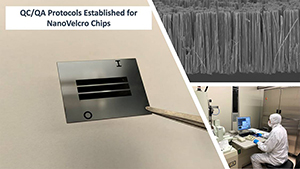Liquid Biopsy 2: NanoVelcro (aka CytoTrapNano® CTC Enumeration Assay)

Principal Investigator: Hsian-Rong Tseng, Ph.D.
Organization: University of California, Los Angeles
Years of IMAT Grants: 2010-2018 (R21 and R33 award)
“Nanotechnology-enabled devices for non-invasive cancer detection.”
What is it?
- This project focused on developing a benchtop microfluidics device featuring embedded nanoscale brushes for capturing cancer-associated cells from patient blood samples in a manner that enables new possibilities for detecting various stages of development and proliferation for many cancer types.
How does this technology intend to change cancer research and patient care?
- This technology improved upon the performance capabilities of existing liquid biopsy technologies like the CellSearch® Assay by more efficiently capturing rare cancer-associated cells from a patient’s blood and allowing for multiple downstream analysis possibilities (such as protein or DNA analysis or cell culturing).
- The NanoVelcro platform has contributed significantly to raising the bar for minimally-acceptable performance capabilities for liquid biopsy technologies.
How is this important for the patient?
- NanoVelcro technology captures circulating tumor cells from a patient’s blood representing a variety of solid tissue cancers, such as prostate cancer, liver cancer, pancreatic cancer, lung cancer and melanoma. The positive identification of known biomarkers in these cells can inform treatment.
- The technology is being made commercially available through CytoLumina Technologies, Corp, which is fundraising to clear its first prognostic test with the FDA for identifying prostate cancer patients at risk of developing treatment resistance.

Example(s) of success:
- The NanoVelcro technology has attracted numerous investors to support commercialization of the technology, which has enabled a variety of clinical research studies. The company is being approached by pharmaceutical companies seeking to use the technology as a companion diagnostic for monitoring treatment outcomes of their new drugs.
- In a relatively small preclinical study, the device was used to successfully distinguish liver cancer patients with aggressive underlying disease and occult metastases, and is expected to have important implications for treatment selection. (Agopian et al., Liver Transpl. 2018; PMCID: PMC6097911)
To learn more about this technology, check out the Tseng Lab website or visit the CytoLumina Technologies, Corp website.

